Local historians write directly about what happened in May 1940:invasion. Later there were 13 months of occupation. Illegal, unprovoked. And in the performance of alleged defenders of freedom.
In the morning of May 10, 1940, the inhabitants of the capital of Iceland, Reykjawík, were awakened by the roar of the plane. Those who stepped out in alarm and looked up at the sky noticed a small biplane circling above the city. The altitude of the aircraft made detailed observation impossible, but if the Icelanders had binoculars, they could see the marks of the British Royal Air Force RAF on the wings of the plane.
Where did the English plane over Iceland come from? The country was neutral and did not participate in the ongoing struggle of World War II. In addition, he did not have an army so he could not pose a threat to any of the warring sides.
However, Iceland, due to its strategic location in the North Atlantic - between Norway, Great Britain, Ireland and Greenland - allowed it to control this important area. In addition, it enabled guarding the shortest sea routes leading from the British Isles to Canada and the USA. It is for these reasons that this small island has become a tasty morsel for both the British and the Germans.
The British biplane flew over Reykjawík several times and disappeared below the horizon. Two hours later, one of the Icelandic policemen on duty spotted a group of ships approaching the coast. Due to the distance, he could not recognize their nationality, so he called the police chief.
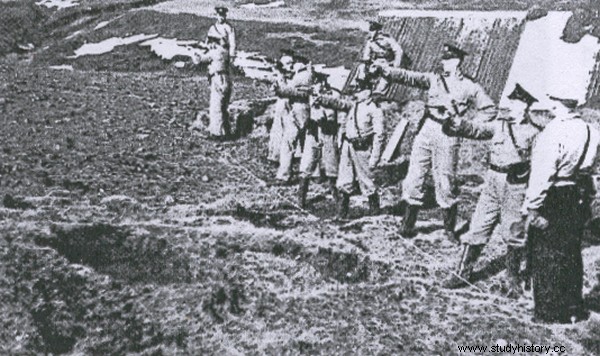
Iceland did not have any armed forces of its own to fight the British. Only the policemen could resist. In the photo from 1940, they are practicing shooting.
The ships had clearly breached Iceland's maritime zone, so the policemen prepared the boats to go out to meet them. However, they did not manage to go to sea, because at 5 ships entered the port. The flags of the Royal Navy were flying on their masts. Thus began the British invasion of Iceland - the only neutral country that fell under English occupation during World War II.
Neutrality? What's up!
On April 9, 1940, the Germans attacked Denmark from land and sea and captured it after several hours of fighting. On the same day, the German attack on Norway began. Realizing Iceland's strategic position, the British government was concerned that the next target of the Wehrmacht would be this Atlantic island.
Therefore, on April 9, he presented the local government with a proposal to assist in maintaining neutrality and accepting a "peace" mission of the British troops. Icelandic Prime Minister Hermann Jónasson has rejected the ultimatum. However, London decided not to take into account the opposition of the Icelanders, to warn the Germans and to set up its own military base on the island.
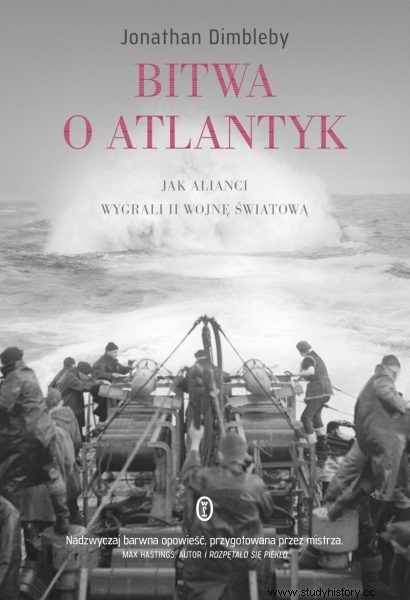
A supporter of decisive action, First Lord of the Admiralty Winston Churchill, referred the matter to the War Cabinet, which made the appropriate decision. Jonathan Dimbleby, author of the recently published book "The Battle of the Atlantic", quotes Churchill's words: Whoever has Iceland in his hand is wielding a pistol, aimed at England, America and Canada . Time was pressing, so the operation was prepared in a hurry. The invasion force was to include two cruisers (HMS "Berwick" and HMS "Glasgow") and two destroyers (HMS "Fearless" and HMS "Fortune").
We will try the weapons at sea!
The landing force was to be the 2nd Royal Marines' Battalion from Bisley, which had been formed just a month ago. Most of his soldiers had just received basic training, and some did not even have that. Heavy weapons were also missing; the soldiers only had rifles, pistols and bayonets. On the other hand, 50 of them received rifles quite recently and have not yet had a chance to fire from them. On May 4, the battalion received small amounts of additional weapons in the form of Bren light machine guns, anti-tank rifles and mortars.
Due to the lack of time, it was decided that the soldiers would familiarize themselves with the new weapons and fire them for the first time ... on board ships, during the cruise to Iceland. There were also no searchlights, means of communication and artillery observers. Many operational targets were not developed until the way to the island, and none of the Brits spoke Icelandic.
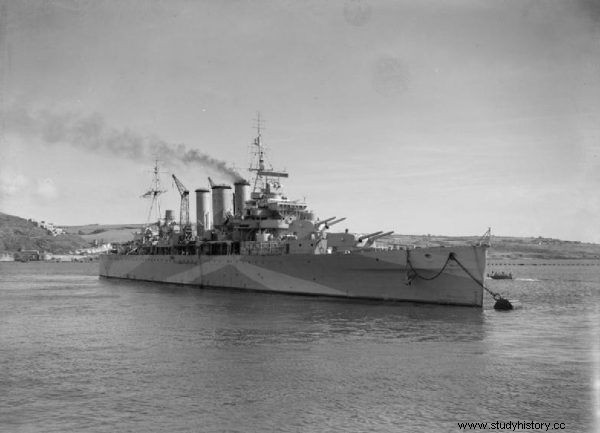
HMS Berwick, who led the invasion force.
The commander of the operation, codenamed "Fork", was Colonel Robert Sturges, a World War I veteran, participant in the Gallipoli and Jutland battles, described as "fearless in action, red in the face and sloppy in the tongue." The invasion force numbered 746 soldiers.
On May 10, the invasion team arrived in Iceland. At. 1:47 local time, the cruiser Berwick launched the Supermarine Walrus reconnaissance flying boat catapult. It was she who awakened some of the people of Reykjavík from sleep. Its task was to conduct a reconnaissance in the coastal waters and in the port. Although the pilot was strictly forbidden to fly over the city, the pilot flew over the Icelandic capital several times. Among those alarmed by his flights was also the German consul Werner Gerlach, who began to have worrying suspicions.
Crowds in the port
Around At 5 a.m., four British ships entered the port of Reykjawík. The head of the local police, Einar Arnalds, wanted to speak to the commander of the invasion force to inform him about the breach of Iceland's neutrality but the British demanded to speak to the Prime Minister of the country, Hermann Jónasson. British soldiers began to descend and were watched by more and more residents of Reykjawik.
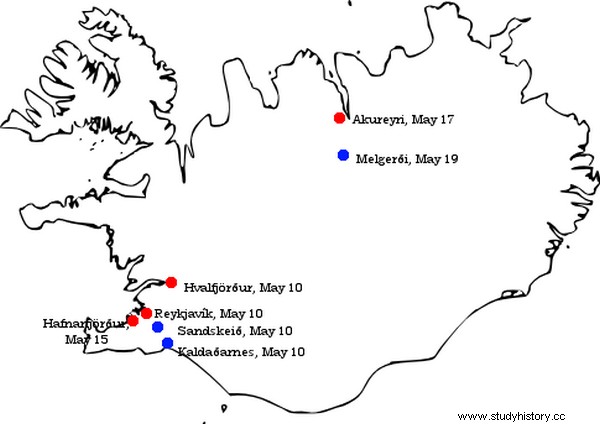
British targets for the invasion of Iceland on May 10, 1940.
The Icelanders did not resist, and the marines quickly began carrying out their assigned tasks. Communication was blocked to prevent the news of the invasion to Berlin from being passed on, strategic points in the form of ports and airports were secured, and separate units were sent to other places to defend them against a possible German counterattack.
Invasion "with the consent of the inhabitants"?
German citizens on the island were also arrested, including the German consul Arnalds, who burned most of the important documents before being arrested. The Germans were loaded onto the ship, taken to Great Britain and interned. On the evening of May 10, the Icelandic government launched a protest against the invasion, accusing the British of violating neutrality and demanding compensation for the damage it had caused. London has promised compensation, economic and military cooperation, and that it will not interfere in the country's internal affairs.
Iceland finally agreed to cooperate, but formally remained a neutral country. As Jonathan Dimbleby writes in "Battle of the Atlantic" Prime Minister Churchill later claimed that the invasion took place "with the consent of the people," but that was untrue. In fact, the entire operation constituted "a blatant violation of international law - and was reminiscent of some of the actions of the Third Reich." The Icelandic government fiercely protested against the "brutal violation" of the country's neutrality, and Icelanders themselves were reluctant towards British soldiers.
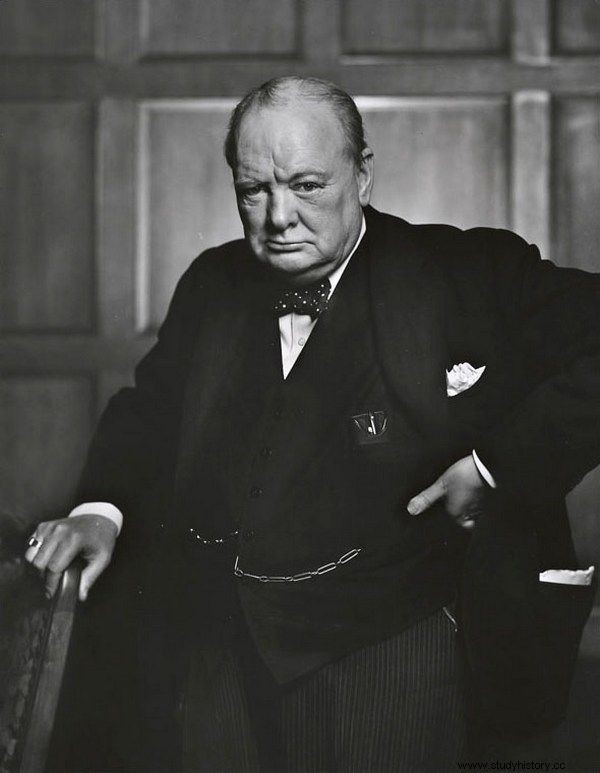
Winston Churchill claimed that the invasion took place with the consent of the Icelanders. To say that it was not true is like saying nothing.
Stacks of cod heads
Two days after the invasion, two transporters landed in the port of Reykjawík and began unloading trucks, armored personnel carriers and supplies of ammunition and equipment intended for British troops on the island (eventually 25,000 soldiers were there). The officer in charge of the operation was Rear Admiral Kenelm Creighton. As we read in "Battle for the Atlantic" , the capital of Iceland did not impress him at all. There were piles of cod heads everywhere, in various stages of decay.
"As soon as I passed one of them, I breathed a sigh of relief and took the handkerchief away from my nose, but I had to cover it immediately again because another pile was growing in my way," he later recalled. The British occupation of neutral Iceland lasted until July 1941. Then the Americans landed there and, at the request of the Icelandic authorities, took over the defense of Iceland. The US Army remained on the island until 1951
